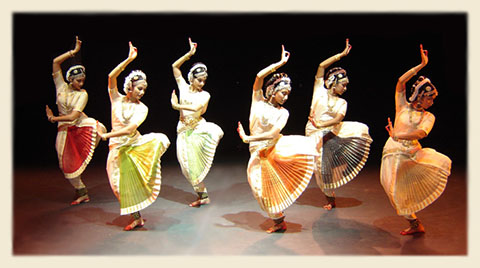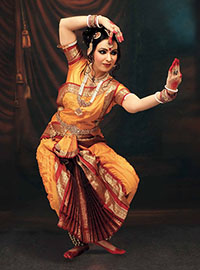 Bharata Natyam, also spelled Bharatanatyam, is a classical Indian dance form that originated in the temples of Tamil Nadu. This dance form is the product of various 19th- and 20th-century reconstructions of Sadir, the art of temple dancers called Devadasis. It was described in the treatise Natya Shastra by Bharata around the beginning of the common era. Bharata Natyam is known for its grace, purity, tenderness, expression and sculpturesque poses. Lord Shiva is considered the God of this dance form. Today, it is one of the most popular and widely performed dance styles and is practiced by male and female dancers all over the world.
Bharata Natyam, also spelled Bharatanatyam, is a classical Indian dance form that originated in the temples of Tamil Nadu. This dance form is the product of various 19th- and 20th-century reconstructions of Sadir, the art of temple dancers called Devadasis. It was described in the treatise Natya Shastra by Bharata around the beginning of the common era. Bharata Natyam is known for its grace, purity, tenderness, expression and sculpturesque poses. Lord Shiva is considered the God of this dance form. Today, it is one of the most popular and widely performed dance styles and is practiced by male and female dancers all over the world.
In Kali Yuga, the center of most arts in India is Bhakti (devotion) and therefore, Bharata Natyam as a dance form and carnatic music set to it are deeply grounded in Bhakti. Bharata Natyam, it is said, is the embodiment of music in visual form, a ceremony, and an act of devotion. Dance and music are inseparable forms; only with Sangeetam (words or syllables set to raga or melody) can dance be conceptualized. Bharata Natyam has three distinct elements to it: Nritta (rhythmic dance movements), Natya (mime, or dance with a dramatic aspect), and Nritya (combination of Nritta and Natya).

Bharata Natyam is considered to be a fire-dance — the mystic manifestation of the metaphysical element of fire in the human body. It is one of the five major styles (one for each element) that include Odissi (element of water), Kuchipudi (element of earth), Mohiniattam (element of air) and Kathakali (element of sky or aether). The movements of an authentic Bharata Natyam dancer resemble the movements of a dancing flame. Contemporary Bharata Natyam is rarely practiced as Natya Yoga, a sacred meditational tradition, except by a few orthodox schools (see Yoga and dance).
Bharata Natyam proper is a solo dance, with two aspects, lasya, the graceful feminine lines and movements, and tandava Ananda Thandavam (Tamil) (the dance of Shiva), masculine aspect.
 In most solo performances, Bharata Natyam involves many split characters that are depicted by the dancer. The dancer will take on numerous characters by switching roles through the swift turn in circle and creates a story line that can be easily followed by the feat of one individual. The characters will be understood by the narrative of the song and the expression, or “abhinaya. However, in more modern times, Bharata Natyam performances have taken stage as group performances involving dramatical performances that require many characters depicted by various dancers. In addition, these dance performances include numerous transitions and formations that are creatively choreographed to enhance the movements along with the music.
In most solo performances, Bharata Natyam involves many split characters that are depicted by the dancer. The dancer will take on numerous characters by switching roles through the swift turn in circle and creates a story line that can be easily followed by the feat of one individual. The characters will be understood by the narrative of the song and the expression, or “abhinaya. However, in more modern times, Bharata Natyam performances have taken stage as group performances involving dramatical performances that require many characters depicted by various dancers. In addition, these dance performances include numerous transitions and formations that are creatively choreographed to enhance the movements along with the music.
At present, Bharata Natyam recitals are usually not performed inside the temple shrine but outside it, and even outside the temple compounds at various festivals. Most contemporary performances are given on the stage with a live ensemble. In popular culture, the adapted, or “semi-classical”, Bharata Natyam has been exposed largely through depiction in popular movies and TV programs.
There are 3 aspects to dance; Nritta, Nritya and Natya. Nritta is a pure dance without any emotions, expressions or sahityam. Nritya has sahityam (a sentence which means something). It has emotions, expressions and has a meaning shown by the hastas. Natya is when a person is portraying a character. There are 4 types of abhinaya in dance. They are
- Anghika – Physical or body movements.
- Vachika – the song being played, poetry
- Aaharya – Ornamentation of a character/dancer e.g. jewellery, costume
- Satvika – Involuntary movements e.g. trembling, break of voice, tears